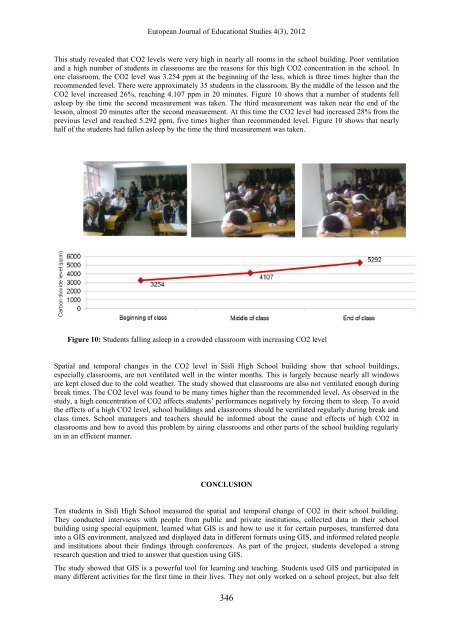Volume 4 Issue 3 (October 2012) - Ozean Publications
Volume 4 Issue 3 (October 2012) - Ozean Publications
Volume 4 Issue 3 (October 2012) - Ozean Publications
Create successful ePaper yourself
Turn your PDF publications into a flip-book with our unique Google optimized e-Paper software.
European Journal of Educational Studies 4(3), <strong>2012</strong><br />
This study revealed that CO2 levels were very high in nearly all rooms in the school building. Poor ventilation<br />
and a high number of students in classrooms are the reasons for this high CO2 concentration in the school. In<br />
one classroom, the CO2 level was 3.254 ppm at the beginning of the less, which is three times higher than the<br />
recommended level. There were approximately 35 students in the classroom. By the middle of the lesson and the<br />
CO2 level increased 26%, reaching 4.107 ppm in 20 minutes. Figure 10 shows that a number of students fell<br />
asleep by the time the second measurement was taken. The third measurement was taken near the end of the<br />
lesson, almost 20 minutes after the second measurement. At this time the CO2 level had increased 28% from the<br />
previous level and reached 5.292 ppm, five times higher than recommended level. Figure 10 shows that nearly<br />
half of the students had fallen asleep by the time the third measurement was taken.<br />
Figure 10: Students falling asleep in a crowded classroom with increasing CO2 level<br />
Spatial and temporal changes in the CO2 level in Sisli High School building show that school buildings,<br />
especially classrooms, are not ventilated well in the winter months. This is largely because nearly all windows<br />
are kept closed due to the cold weather. The study showed that classrooms are also not ventilated enough during<br />
break times. The CO2 level was found to be many times higher than the recommended level. As observed in the<br />
study, a high concentration of CO2 affects students’ performances negatively by forcing them to sleep. To avoid<br />
the effects of a high CO2 level, school buildings and classrooms should be ventilated regularly during break and<br />
class times. School managers and teachers should be informed about the cause and effects of high CO2 in<br />
classrooms and how to avoid this problem by airing classrooms and other parts of the school building regularly<br />
an in an efficient manner.<br />
CONCLUSION<br />
Ten students in Sisli High School measured the spatial and temporal change of CO2 in their school building.<br />
They conducted interviews with people from public and private institutions, collected data in their school<br />
building using special equipment, learned what GIS is and how to use it for certain purposes, transferred data<br />
into a GIS environment, analyzed and displayed data in different formats using GIS, and informed related people<br />
and institutions about their findings through conferences. As part of the project, students developed a strong<br />
research question and tried to answer that question using GIS.<br />
The study showed that GIS is a powerful tool for learning and teaching. Students used GIS and participated in<br />
many different activities for the first time in their lives. They not only worked on a school project, but also felt<br />
346

















